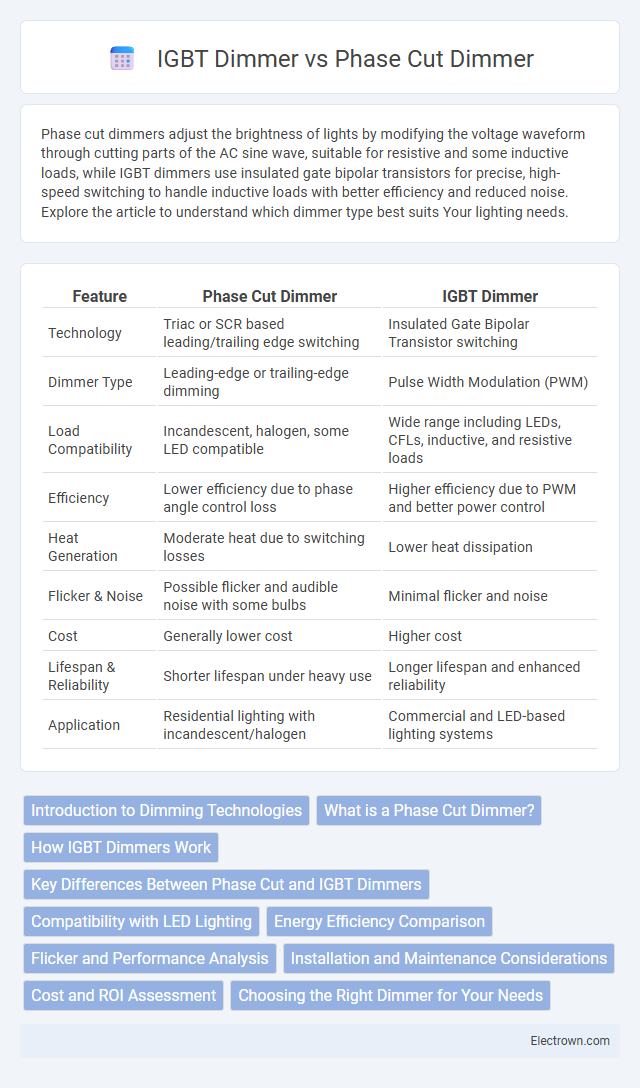Phase cut dimmers adjust the brightness of lights by modifying the voltage waveform through cutting parts of the AC sine wave, suitable for resistive and some inductive loads, while IGBT dimmers use insulated gate bipolar transistors for precise, high-speed switching to handle inductive loads with better efficiency and reduced noise. Explore the article to understand which dimmer type best suits Your lighting needs.
Table of Comparison
| Feature | Phase Cut Dimmer | IGBT Dimmer |
|---|---|---|
| Technology | Triac or SCR based leading/trailing edge switching | Insulated Gate Bipolar Transistor switching |
| Dimmer Type | Leading-edge or trailing-edge dimming | Pulse Width Modulation (PWM) |
| Load Compatibility | Incandescent, halogen, some LED compatible | Wide range including LEDs, CFLs, inductive, and resistive loads |
| Efficiency | Lower efficiency due to phase angle control loss | Higher efficiency due to PWM and better power control |
| Heat Generation | Moderate heat due to switching losses | Lower heat dissipation |
| Flicker & Noise | Possible flicker and audible noise with some bulbs | Minimal flicker and noise |
| Cost | Generally lower cost | Higher cost |
| Lifespan & Reliability | Shorter lifespan under heavy use | Longer lifespan and enhanced reliability |
| Application | Residential lighting with incandescent/halogen | Commercial and LED-based lighting systems |
Introduction to Dimming Technologies
Phase cut dimmers control light intensity by adjusting the voltage waveform through either leading-edge or trailing-edge techniques, making them compatible with many traditional incandescent and halogen bulbs. IGBT dimmers utilize insulated-gate bipolar transistors to provide precise, high-frequency switching, offering better efficiency and smoother dimming for LED and electronic transformer loads. Understanding these technologies helps you select the most suitable dimmer for your lighting system's performance and compatibility requirements.
What is a Phase Cut Dimmer?
A Phase Cut Dimmer controls light intensity by adjusting the voltage waveform supplied to the lamp, either by cutting the beginning (leading edge) or end (trailing edge) of the AC phase. These dimmers work by chopping a portion of the AC cycle, allowing precise dimming of incandescent, halogen, and some LED lights. Your choice between a Phase Cut Dimmer and an IGBT dimmer depends on compatibility with the lighting load and desired dimming smoothness.
How IGBT Dimmers Work
IGBT dimmers operate by rapidly switching the insulated-gate bipolar transistor on and off to control the power delivered to lighting loads, enabling precise voltage regulation and smoother dimming performance. Unlike traditional phase cut dimmers that simply chop the AC waveform to reduce brightness, IGBT dimmers modulate the electrical current at a higher frequency, resulting in reduced flicker and electromagnetic interference. This advanced switching mechanism allows IGBT dimmers to efficiently manage different load types, including LED and electronic transformer lights, providing improved compatibility and energy savings.
Key Differences Between Phase Cut and IGBT Dimmers
Phase cut dimmers regulate light intensity by chopping the AC waveform at the beginning or end of each cycle, suitable for incandescent and some LED lights. IGBT dimmers use insulated-gate bipolar transistors to provide more precise and efficient control, handling higher power loads with better performance in LED and electronic transformer applications. Your choice depends on compatibility with the lighting type and the desired dimming smoothness, where IGBT dimmers often offer enhanced stability and energy efficiency.
Compatibility with LED Lighting
Phase cut dimmers are widely compatible with many types of LED lighting, especially those designed for trailing-edge dimming, providing smooth dimming and reducing flicker. IGBT dimmers offer precise control and are ideal for LED fixtures requiring high-frequency switching and complex load handling, enhancing performance in advanced lighting systems. Understanding the specific LED driver requirements ensures optimal compatibility and efficient dimming response between phase cut and IGBT dimmers.
Energy Efficiency Comparison
Phase cut dimmers typically operate by trimming the voltage waveform, which can lead to some energy loss as heat, making them less efficient compared to IGBT dimmers. IGBT dimmers utilize advanced semiconductor technology for precise switching, resulting in higher energy efficiency and reduced power wastage. Your lighting system benefits from lower energy consumption and improved performance when using IGBT-based dimming solutions.
Flicker and Performance Analysis
Phase cut dimmers often cause flicker due to their abrupt voltage switching, leading to inconsistent light output especially with LED loads. IGBT dimmers use insulated-gate bipolar transistors to provide smooth, high-frequency switching, significantly reducing flicker and enhancing overall performance. Their precise control allows for improved energy efficiency and better compatibility with a wider range of lighting technologies.
Installation and Maintenance Considerations
Phase cut dimmers are easier to install with standard wiring and compatible with most incandescent and halogen bulbs, requiring minimal maintenance due to their simple design. IGBT dimmers involve more complex installation, often needing specialized wiring and careful consideration of load types to prevent damage, but they offer advanced electronic control and longevity with occasional firmware updates or component checks. Your choice depends on balancing straightforward installation and low upkeep versus enhanced performance and reliability in demanding applications.
Cost and ROI Assessment
Phase cut dimmers typically offer lower upfront costs due to their simpler design, making them a budget-friendly option for standard lighting applications. IGBT dimmers, while initially more expensive, provide superior energy efficiency and longer lifespan, resulting in better ROI over time through reduced maintenance and energy savings. Assessing your project's specific energy consumption and maintenance requirements will help determine which dimmer type delivers the most cost-effective solution.
Choosing the Right Dimmer for Your Needs
Choosing the right dimmer involves understanding that phase cut dimmers work by chopping the AC waveform to reduce voltage, making them ideal for incandescent and halogen lights. IGBT dimmers offer precise, efficient control using semiconductor switches, better suited for LED and electronic loads with complex power requirements. Your choice depends on the type of lighting, compatibility, and the desired level of dimming accuracy and energy efficiency.
Phase cut dimmer vs IGBT dimmer Infographic

 electrown.com
electrown.com